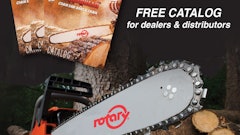Documents easier to locate, less likely to lost
Saves time and space
Lowers storage and retrieval expenses
Documents can be searchable by keywords
Documents can be shared
Eliminates photocopying
No need to purge files annually
Documents can integrate with QuickBooks
Increases employee productivity
Provides disaster recovery
Eliminates document wear and tear
Will Paperless Work For You?
Any piece of paper a company would normally file—including estimates, contracts, customer notes, materials bills, etc.—can be scanned and filed on the computer, resulting in less office clutter, less time wasted searching for files, and less money spent on paper and printer ink.
Landscape companies that would benefit most from a paperless office would be generating at least $500,000 in annual revenue, according to Dickran Babigian, president of consulting and software firm Navix. More importantly, the company would have at least one dedicated office staff member who would be responsible for scanning documents into the computer, etc.
Still, as Glenn Zior of Clip Software and Clip Lawn Care points out, you’d be hard-pressed to find any contractor who wished he had more paperwork sitting around. “When I visit contractors, even the smaller companies, virtually all of them say they wish they could go paperless,” Zior relates. “They are receptive to the idea, for sure. It’s just a matter of execution. The dollar investment can actually be pretty low. The main investment is in time. But when you think about it, it really doesn’t have to be that much of an undertaking, and the time saved later can more than make up for it.”
Contracts, Invoices & Materials Bills
Clip Lawn Care has had an almost 100% paperless office since day one. Even with contracts, the paper copy goes right in the trash once it’s scanned into the computer. The next step is to get 100% of customer bills sent via e-mail.
The only thing that isn’t at least partially paperless at Clip Lawn Care is accounts payable, though that too may change soon. “The IRS now allows a PDF scan as a legitimate receipt,” Zior explains. “So materials bills and other receipts could also go paperless now, making it much easier for contractors to keep track of these things and recover the costs.”
Estimates
“The biggest issue is finding the estimate when a customer calls,” Zior relates. “Understandably, busy contractors have a growing pile of ‘to be filed’ paperwork ... namely estimates. It’s not always a quick process to get an answer back to the customer. With an electronic filing system, it can be more orderly and much faster.”
MowCow Lawn & Landscape in Fairfax Station, VA, has recently begun heading in the paperless direction for this very reason. “We wanted important documents like estimates and notes from the field to be easier to find, while also reducing the chance of their getting permanently lost,” owner Richard Lindsay says. “Even with the best paper filing system, things always seem to get misplaced.”
Reminder Notes
Post-it notes and other hand-scribbled reminders also lend themselves well to a paperless system. “You want to be able to retrieve and share notes on customers and specific phone calls without having to dig out a paper file or track someone else down in the office,” Babigian says. “The goal is to get rid of all those notes around the office, which are easily lost, forgotten or simply not legible.”
Communicating in the Field
An electronic post-it note system comes in especially handy when you are out in the field. You can retrieve information, log notes and respond to queries from customers or the office on your laptop computer or mobile communications device—without having to scribble a note to yourself or drive back to the office.
According to Zior, many landscapers lose money by not billing for extra work they’ve done. The ability to electronically log the information in the field so it syncs back to the office can make a big difference over the course of a season.
Mike Ryan of Tempco Pest Control in Fort Meyers, FL, recently began transitioning to a paperless office. “I’d like to get to a point where I don’t use any paper whatsoever with routing, scheduling and daily operations,” he says. “We’ll save two trees a year.”
Ryan, a Clip Software user, is currently transfixed on two areas: customer information and routing. All contracts are scanned into the computer. “Clip lets me easily file the information by customer name so everything I have on a given customer is all in one place,” he says.
To assist with mobile communications, Ryan was initially thinking about putting laptops in each of his 10 trucks. Instead, he’s gone with Clip2Go mobile palm devices. Drivers can access customer notes and enter new data. “At the end of the day, they can send me the information over the Internet, or bring me the device the next morning to sync it to the main computer,” Ryan tells. “Either way, it saves me hours of paperwork each day.”
Ryan is also saving big by not having to print route sheets for his drivers. Clip2Go links to a GPS system, allowing it to schedule routes in the most efficient order, helping reduce fuel expenditures.
Getting Started Cheap
Thinking you might like to head in the paperless direction? Babigian says it is the perfect time of year to begin this type of project. The amount of time you’ll spend transitioning depends on how much you decide to actually undertake.
While the implementation of incoming documents is pretty straightforward in terms of time, committing to an electronic conversion of your prior paper documentation is another story. Based on the volume of documents already in storage, Babigian says prior-year conversions are usually done as time allows.
If you’re just going to scan documents and simply file them in folders you’ve set up on your computer, you can get going immediately. “Prior to that, though, you should carefully consider the file structure and document naming scheme,” Babigian advises. “Remember, one of the goals of going paperless is quick and easy retrieval of information.”
Document Filing Software
While a simple, low-investment system can help you achieve some of the objectives of going paperless, document filing software is available that can help you accomplish even more.
“If you don’t employ a more formal documentation software program to file and secure the documents,” Babigian points out, “you are unlikely to realize some of the benefits of going paperless. Secure file sharing is also more difficult. You could password-protect sensitive documents, but that provides its own set of challenges in terms of remembering all those passwords.”
Clip Software has document filing features. eCopy ShareScan quickly turns paper documents into digital files. A couple of other popular products are also available from a company called Cabinet NG. CNG-SAFE is document management software, while CNG-Books integrates with QuickBooks Enterprise Solutions to share billing, credit card, payment and other information.
When going paperless, Babigian says, it’s very beneficial to invest in programs that integrate with QuickBooks, such as Cabinet NG, to streamline data entry. “Another feature I like about the QuickBooks link is the ability to have employees approve documents, such as vendor invoices, via electronic submission,” Babigian points out. “For example, the bookkeeper could send a document electronically to an account manager for review, and the account manager could sign off and approve the invoice without ever touching or seeing a physical piece of paper. The approval is then sent back to be filed electronically.”
Have a Backup Strategy
While there are many differences between a paperless office and one that is bogged down by piles of files, there is also a similarity: Files and data can be lost. “As with any server or computer-based system, there needs to be a solid backup strategy,” Babigian reminds. “Off-site backup storage is always important.”
Zior says most of Clip Software’s customers backup on CD-ROM. “I’d advise getting an automated program and pop a CD in every night, or at least once or twice a week,” he adds. “How often you backup your files depends on how much data you’re willing to re-enter.” Online services are also available for backing up files.
Making Paperless Happen
A final thing to consider when transitioning to paperless is who will do the work to make it happen. Babigian says smaller companies will most likely have the bookkeeper perform the function, while large companies may have a single person dedicated to it.
“Learning to scan the documents is very simple, so no cross-training is required, per se,” Babigian points out. “However, if a company is employing a product like CNG-SAFE in the secure filing of its documents, someone should be cross-trained on how to file and secure the electronic documentation.”
Depending on how far you want to go in the paperless direction, there will be some investments that have to be made—in both dollars and time. Consider the near- and long-term benefits of going paperless, their associated savings, and the issues that have plagued your company due to filing inefficiencies. More contractors are going paperless, and wish they would have a long time ago.
PICKING A GOOD SCANNER
The first tool you need if you’re thinking about going paperless is a document scanner. Consultant Dickran Babigian says you should look for the following characteristics:
High capacity
Duplex (double-sided, one pass-through)
File format outputs: TIFF, JPEG and searchable PDF
Output resolution that can vary from 75 to 600 dpi
Document handler that can hold up to 50 sheets
Larger companies will also appreciate a scanner that:
Is networkable
Has security features
Has email capability
Does black-and-white, grayscale and color
Has output methods to scan to network share, scan to print, scan to email, scan to portable USB drive, scan to FTP, and scan to fax


























